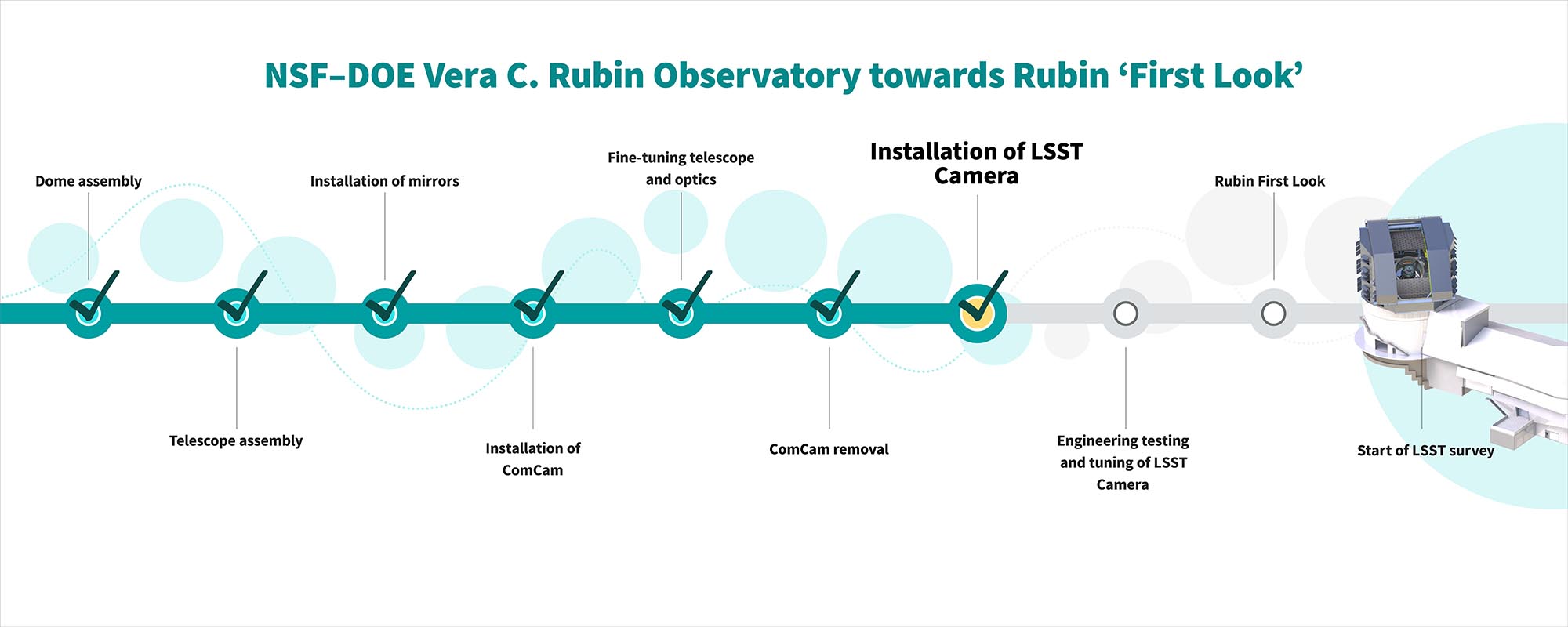NSF–DOE Vera C. Rubin Observatory Installs LSST Camera on Telescope


Using the largest digital camera in the world, Rubin Observatory will soon be ready to capture more data than any other observatory in history
NSF–DOE Vera C. Rubin Observatory, funded by the U.S. National Science Foundation and the U.S. Department of Energy’s Office of Science, has achieved a major milestone with the installation of the LSST Camera on the telescope. With the final optical component in place, Rubin enters the last phase of testing before capturing long-awaited and highly-anticipated First Look images, followed by the start of the Legacy Survey of Space and Time (LSST).
In early March, the NSF–DOE Vera C. Rubin Observatory team on Cerro Pachón in Chile lifted the car-sized LSST Camera into position on the Simonyi Survey Telescope. This milestone is a significant step forward in the decades-long story of the LSST Camera’s design, construction, and transport to Chile.
Rubin Observatory is jointly funded by the U.S. National Science Foundation and the U.S. Department of Energy’s Office of Science. Rubin is a joint Program of NSF NOIRLab and DOE’s SLAC National Accelerator Laboratory, who will cooperatively operate Rubin.
“The installation of the LSST Camera on the telescope is a triumph of science and engineering,” said Harriet Kung, Acting Director of the Department of Energy’s Office of Science. “We look forward to seeing the unprecedented images this camera will produce.”
“This is the last major step in the construction of one of the most ambitious scientific facilities ever created,” said NSF Director Sethuraman Panchanathan. “It’s a testament to the technical prowess and dedication of the entire NSF–DOE Rubin Observatory team — and the scientific community that has been striving to get to this point for over two decades.”

The LSST Camera was constructed at SLAC, incorporating cutting-edge technology to deliver an unprecedented view of the night sky.
“This is a pivotal moment for the teams from all around the world who collaborated to design and build the camera,” said Aaron Roodman, Director of the LSST Camera and Deputy Director of Rubin Construction from SLAC National Accelerator Laboratory (SLAC). “We will achieve a level of clarity and depth never seen before in images covering the entire southern hemisphere sky.”
After the camera was completed in April 2024, the team transported it to Chile in a carefully coordinated effort to ensure its safe arrival at the Rubin Observatory.
“The installation of the LSST Camera is the result of years of meticulous planning and rigorous testing,” said Kevin Reil from SLAC, the System Integration Scientist for Rubin Observatory. “Every step was carefully orchestrated to ensure the camera is positioned with absolute precision. Now we’ll move forward with the final testing phase, bringing us closer than ever to Rubin’s first images.”
The LSST Camera is the largest digital camera ever built. Weighing over 3000 kilograms, the 3200-megapixel camera is at the center of Rubin Observatory’s optical system, which also features an 8.4-meter combined primary/tertiary mirror and a 3.5-meter secondary mirror. Rubin Observatory’s innovative design enables it to simultaneously capture faint objects and objects that change in position or brightness within its wide field of view.
Using the LSST Camera, Rubin Observatory will repeatedly scan the southern night sky for a decade, creating an ultra-wide, ultra-high-definition time-lapse record of the Universe. This endeavor will bring the night sky to life, yielding a treasure trove of discoveries: asteroids and comets, pulsating stars, and supernova explosions, to name a few.
